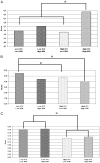Level of NICU quality of developmental care and neurobehavioral performance in very preterm infants
- PMID: 22492762
- PMCID: PMC4074610
- DOI: 10.1542/peds.2011-0813
Level of NICU quality of developmental care and neurobehavioral performance in very preterm infants
Abstract
Objective: To examine the relation between the neurobehavior of very preterm infants and the level of NICU quality of developmental care.
Methods: The neurobehavior of 178 very preterm infants (gestational age ≤29 weeks and/or birth weight ≤1500 g) from 25 NICUs participating in a large multicenter, longitudinal study (Neonatal Adequate Care for Quality of Life, NEO-ACQUA) was examined with a standardized neurobehavioral assessment, the NICU Network Neurobehavioral Scale (NNNS). A questionnaire, the NEO-ACQUA Quality of Care Checklist was used to evaluate the level of developmental care in each of the NICUs. A factor analyses applied to NEO-ACQUA Quality of Care Checklist produced 2 main factors: (1) the infant-centered care (ICC) index, which measures parents' involvement in the care of their infant and other developmentally oriented care interventions, and (2) the infant pain management (IPM) index, which measures the NICU approach to and the procedures used for reducing infant pain. The relations between NNNS neurobehavioral scores and the 2 indexes were evaluated.
Results: Infants from NICUs with high scores on the ICC evidenced higher attention and regulation, less excitability and hypotonicity, and lower stress/abstinence NNNS scores than infants from low-care units. Infants from NICUs with high scores on the IPM evidenced higher attention and arousal, lower lethargy and nonoptimal reflexes NNNS scores than preterm infants from low-scoring NICUs.
Conclusions: Very preterm infant neurobehavior was associated with higher levels of developmental care both in ICC and in IPM, suggesting that these practices support better neurobehavioral stability.
Figures
Comment in
-
Developmental care for premature infants: a state of mind.Pediatrics. 2012 May;129(5):e1322-3. doi: 10.1542/peds.2012-0511. Epub 2012 Apr 23. Pediatrics. 2012. PMID: 22529274 No abstract available.
References
-
- Perlman JM. Neurobehavioral deficits in premature graduates of intensive care—potential medical and neonatal environmental risk factors. Pediatrics. 2001;108(6):1339–1348 - PubMed
-
- Aucott S, Donohue PK, Atkins E, Allen MC. Neurodevelopmental care in the NICU. Ment Retard Dev Disabil Res Rev. 2002;8(4):298–308 - PubMed
-
- Newnham CA, Inder TE, Milgrom J. Measuring preterm cumulative stressors within the NICU: the Neonatal Infant Stressor Scale. Early Hum Dev. 2009;85(9):549–555 - PubMed
-
- Byers JF. Components of developmental care and the evidence for their use in the NICU. MCN Am J Matern Child Nurs. 2003;28(3):174–180, quiz 181–182 - PubMed
-
- Slevin M, Farrington N, Duffy G, Daly L, Murphy JF. Altering the NICU and measuring infants’ responses. Acta Paediatr. 2000;89(5):577–581 - PubMed
Publication types
MeSH terms
Grants and funding
LinkOut - more resources
Full Text Sources
Medical


